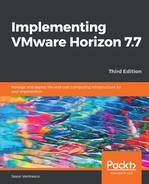App Volumes is configured using a web-based GUI accessed on the App Volumes Manager server. For information about options not used, or otherwise referenced, during the configuration process, consult the VMware App Volumes documentation (https://docs.vmware.com/en/VMware-App-Volumes/index.html). The following steps outline the App Volumes configuration process:
- Log in to the App Volumes Manager web console using the web browser, and the FQDN of the App Volumes Manager server or the shortcut on the desktop of the App Volumes Manager server. In the example provided, the URL is https://rtpappv01.vjason.local. No login is required during the initial configuration process.
- On the Welcome to App Volumes Manager page, click Get Started.
- In the License section of the configuration wizard, click Edit to enter your license information and then click Next. If you do not yet have a license, click Next to continue using the evaluation license.
- In the Active Directory Domains section of the configuration wizard, populate the fields with your Active Directory information and the App Volumes service account ID and password, as shown in the following screenshot, and then click Register:

The default Security: setting is Secure LDAP (LDAPS), but if your Active Directory does not have that configured, you will get an error when you click Register. You may need to change the setting to basic LDAP, which is unencrypted but should work.
- In the updated Active Directory Domains section of the configuration wizard, click Next.
- In the Administrator Roles section of the configuration wizard, search for the security group that contains the App Volumes admins, as shown in the following screenshot, and then click Assign:

- In the updated Administrator Roles section of the configuration wizard, click Next.
- In the Machine Managers section of the configuration wizard, provide the values for your vCenter Server, as shown in the following screenshot, and then click Save; you may review the various vCenter options and their purpose, but it is not necessary to change them at this time. In the following screenshot, we are connecting to that server using the svc-appvolumes account, which has only those vCenter permissions outlined previously in this chapter:

Additional vCenter servers may be added once the initial configuration is complete.
- If your App Volumes Manager server does not trust the issuing certificate authority for your vCenter host, an Untrusted Certificate notification will appear next. Review the certificate details to ensure they are accurate and then click Accept.
Refer to the App Volumes Administration Guide (https://docs.vmware.com/en/VMware-App-Volumes/index.html) for instructions on how to modify your App Volumes Manager server to trust certificate authorities.
- In the updated Machine Managers section of the configuration wizard, click Next.
- In the updated Storage section of the configuration wizard, use the Default Storage Location drop-down menus to select vSphere datastores that are accessible to all of your Horizon vSphere hosts. Leave the various Path locations at their defaults, as shown in the following screenshot, and then click Save:

The example provided uses a single host with local storage; a production environment that uses VSAN or remotely mounted shared volumes will look slightly different.
- In the Confirm Storage Settings pop-up window, click the Import volumes immediately radio checkbox and then click Set Defaults.
- In the Settings section of the configuration wizard, review the different options for further customizing App Volumes. It is not necessary to make any further changes, but if you intend to use writable volumes, note the Writable Volume Backups settings, as shown in the following screenshot. Click Save when finished:

Your App Volumes Manager server has been configured and is now available for use. It is recommended that you deploy at least one additional App Volumes Manager servers for load balancing and availability purposes. The following section outlines how to deploy additional App Volumes Manager servers.
